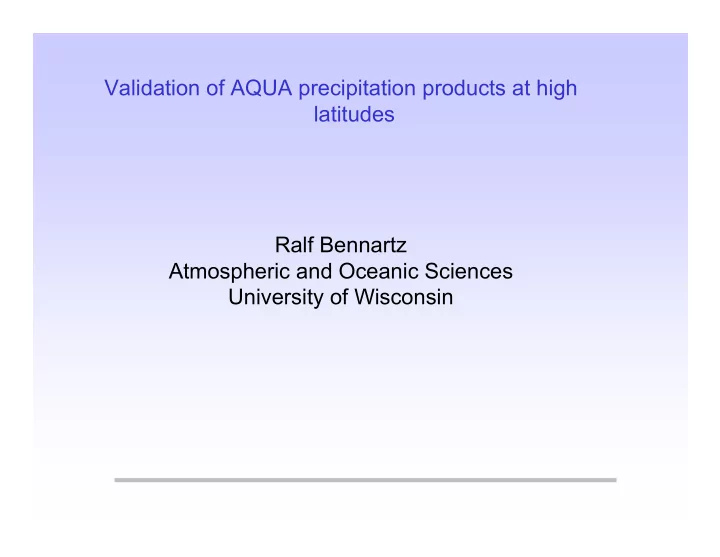

Validation of AQUA precipitation products at high latitudes Ralf Bennartz Atmospheric and Oceanic Sciences University of Wisconsin
Overview • AMSU/HSB navigation • Mapping of HSB to AMSU resolution • Precipitation: Why is it important? • What validation data do we collect? • Where are we? • What is coming next?
AMSU/HSB navigation � Performed cross- correlation analysis with 150 GHz (free of precipitation and heavy clouds) convolved land/sea mask � Accuracy of the method is within 0.1-0.2 FOVs � For the case we looked at the navigation is accurate to within the methods limits
Observation geometry of AMSU/HSB 3dB effective fields of view for AMSU-A and AMSU-B HSB: Slight undersampling in along- track direction for the innermost scan positions (Bennartz, JAOT, 2000)
Optimal mapping of different instruments to of passive mw measurements ÿ Find neighboring pixels i=1,..,N and associated weights so that N T a T Â = B i Bi i 1 = ÿ where T B is the brightness temperature that would be observed by the low resolution mw sensor ÿ Weights are determined via Backus-Gilbert method. This method allows to optimally resemble the spatial sensitivity of the target sensor
Accuracy of method (AMSU-A 89 GHz versus convolved AMSU-B 89 GHz for four transects) Difference A-B for BG-method and simple averaging Rmse-BG: 1.7 K RMSE-Ave:3.2 K Note the strong deviations for the simple averaging in regions where there are strong gradients in TB TB 89 GHz for 89 transects
Precipitation • Spatial and temporal variation of precipitation largely unknown • We can learn much from TRMM, but high latitude cold season is different from tropical precipitation • Precipitation events are typically more shallow • Freezing level is typically low, so ice phase becomes more important • Rain rate is usually not as high as in the tropics • NASA/NASDA/ESA will put considerable resources in extending knowledge about mid/high latitude precipitation (GPM)
Precipitation: What problems do we face? 1. Physics: Understanding of relations between cloud-microphysics, rain rate at ground, and satellite signal. 2. Technical and scientific validation of algorithms. (But: what would be a valid calibration reference for the satellite retrievals?) 3. Sampling issues associated with the diurnal cycle of precipitation
Passive microwave precipitation signal • Most directly linked to • All types of surfaces surface precipitation • More indirect • Over cold (water) surfaces only
What do we do? 1. Collection of validation data 2. Comparsion with AQUA (while AMSR/AMSU/HSB data were not available we started with NOAA data) 3. Simulation studies to understand the relation between cloud microphysics, rainrate and radiometric signal
Dedicated validation observations Colocated radar/AQUA (UW-Madison/SMHI) • Data coverage: August 2002-ongoing. • AQUA AMSR-E/AMSU/HSB • Latitude range 50 N -70 N • Network of 25 radars • Radar reflectivities every 15 minutes • Gauge-adjusted rain rates every 15 minutes • volume scans of Gotland radar
Dedicated validation AQUA observations for rain estimates ÿ Take coincident radar observations which each AQUA overpass over the Baltic area ÿ September 2002: 44 overpasses ÿ October 2002: 60 ÿ November 2002: 57 ÿ December 2002: 60 ÿ January 2002: 58 ÿ Ongoing efforts for at least one year
Observation geometry Altitude of radar beam (elevation 0.5°): @100km distance: 2.2 km @200km distance: 5.2 km 273 K isothermal typically at 2-3 km
NOAA15 overpass 13 September 2000, 06:43 UTC Radar composite RGB AVHRR ch3,4,5 PC product RGB: red: very light green:light/moderate blue:intense
Different precipitation events Graupel Frontal (Cold air outbreak) Thunderstorm precipitation Radar reflectivity [dBz]
Radar versus passive microwave precipitation estimate Graupel Frontal Thunderstorm (Cold air outbreak) precipitation
Comparison of rain events (monthly mean for all pixels with rain rate > 1 mm/h) C : 0.76 BIAS: 0.19 mm/h (radar high) RMSE: 0.93 mm/h
Sampling issues at 60 O N N15 N16 AQUA
Simulation studies � Studied the sensitivities of observed TBs at HSB frequencies to cloud ice/rain � 150 GHz shows best sensitivity, while only little affected by variations in surface emissivity � 183+-7 less sensitiveto precip but surface completely obstructed � 183+-1/3 do not see much precipitation at high latitudes � Study in press Radio Science Bennartz and Bauer (2003)
Outlook � Ongoing data collection (radar composites and volume scans) efforts for at least one year � Further simulation studies on the impact of precipitation on 150,183+-X GHz � Systematic investigation of possible biases etc for different synoptic situations (convective/stratiform precipitation) together with Staelin � Comparison AMSU/HSB-AMSR-E
Brightness temperature depression due to ice particle scattering as function of surface emissivity for intensive convection • Strongest scattering signal at 150 GHz • Only 85 GHz shows sensitivity to surface emissivity
Recommend
More recommend